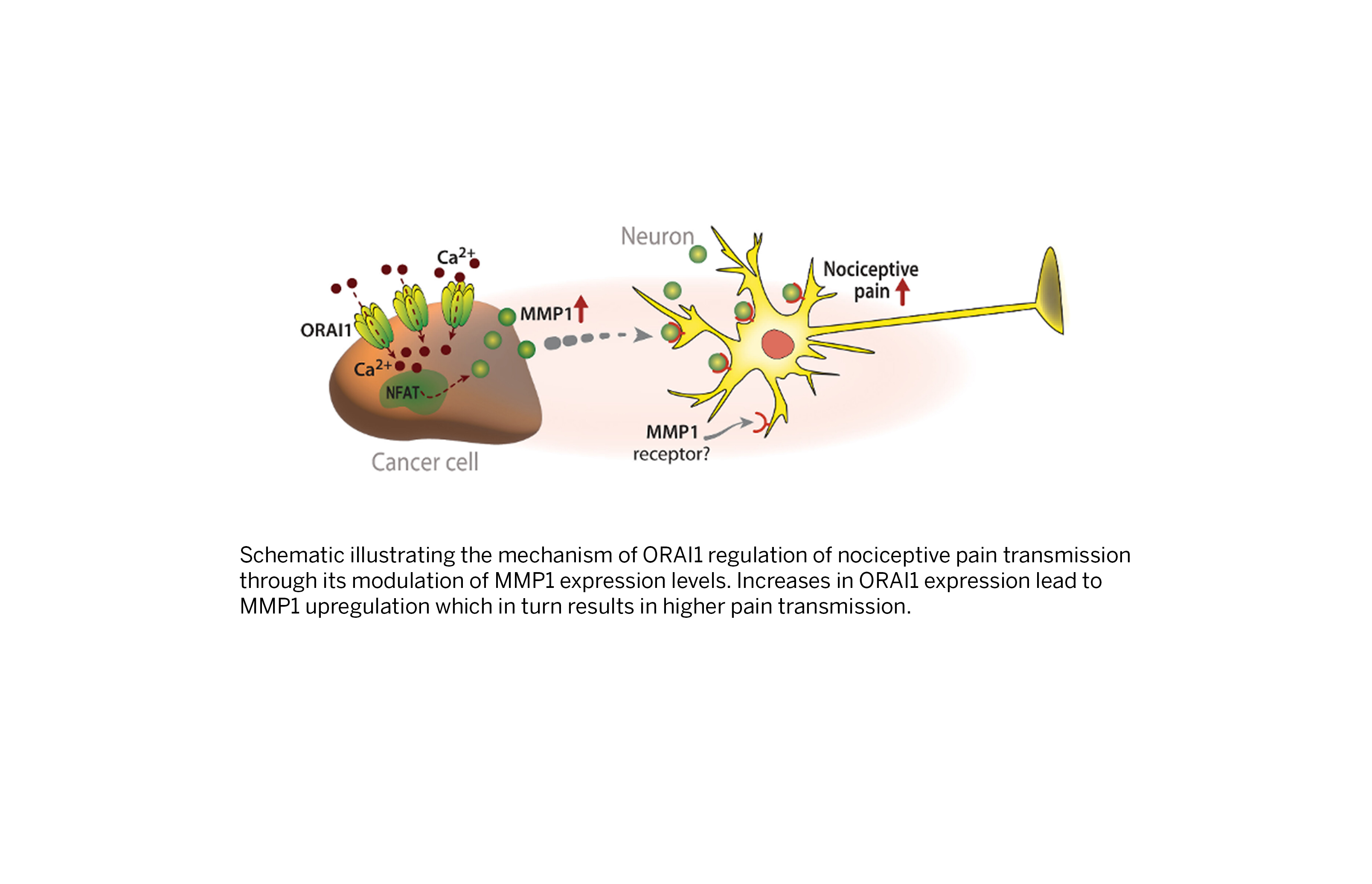Inhibition of the Calcium Channel ORAI1 as a Therapeutic Strategy for the Treatment of Oral Cancer and Associated Allodynia
A non-surgical method for effectively treating both oral cancer and related pain.

Technology
The Lacruz Lab has determined that the Ca2+ ion channel ORAI1 is an attractive therapeutic target for both reducing oral tumor growth and alleviating allodynia. ORAI proteins (all homologs) in the plasma membrane mediate Ca2+ influx as part of the store-operated Ca2+ entry (SOCE) pathway, which has been associated with cancer cell proliferation. In proof of concept work (Son et al. Sci Signal 2023), the research group found that the ORAI1 and ORAI2 genes were significantly upregulated in tongue tumors relative to normal tissue using bulk RNA-seq analysis, highlighting their potential applicability as therapeutic targets. To demonstrate pharmacological inhibition in vitro, Synta-66 (small molecule inhibitor) was used to block ORAI1 channel in HSC-3 cells, resulting in SOCE elimination and oral tumor growth attenuation. Moreover, in genetic validation experiments, shRNA knockdown of ORAI1 (shORAI1) in HSC-3 cells reduced SOCE by ~70% through ORAI1 inhibition, while CRISPR/Cas9 ORAI1 knockout reduced SOCE by ~96.5% in HSC-3 cells. In addition to reduced SOCE activity and tumor growth, WT mice inoculated with shORAI1-transfected MOC-2 cells in the paw (xenograft paw model of oral cancer) also exhibited a significant decrease in hypersensitivity to both mechanical and thermal stimuli at 2-3 weeks post-inoculation. In mechanistic experiments, the lab determined that the excitability of trigeminal ganglion neurons, which relay oral tumor pain signals, increases as a function of ORAI1 expression; specifically, elevated ORAI1 expression leads to MMP1 upregulation which in turn results in higher pain transmission, as MMP1 increases action potentials in trigeminal ganglia. Paw tissues inoculated with shORAI1 HSC-3 cells showed significant down-regulation of ORAI1 and MMP1 expression. ORAI1 inhibition via Synta-66 also attenuated the increase in MMP1 expression, suggesting pharmacological inhibition is effective in modulating SOCE and oral cancer pain. Taken together, these genetic, mechanistic, and pharmaceutical experiments establish ORAI1 as a promising target for the treatment of oral cancer and associated pain.
Development Status
Secretome analysis from the supernatant of HSC-3 CRISPR/Cas9 ORAI1 KO cells
Background
Oral cancer is the most prevalent form of head and neck cancer, with an annual diagnosis rate of approximately 3% in the US. The disease is typically associated with squamous cell carcinomas that develop in the epithelial layer of the tongue due to epithelial dysplasia. As the cancer progresses, oral cancer cells release nociceptive mediators that activate and sensitize primary afferent neurons, leading to oral pain (allodynia). Unfortunately, early diagnosis and management of oral cancers are challenging, resulting in high morbidity and mortality rates. The average 5-year survival rate from oral cancer is 64.3% in the US, yet approximately 70% of oral cancer cases are diagnosed during advanced stages, significantly decreasing the 5-year survival rate. If the cancer has metastasized at the time of diagnosis, the survival rate drops to 38.5%. The primary treatment option for oral cancers is surgery (tumor resections), that can lead to speech difficulties negatively impacting quality of life. Chemotherapy (cisplatin, 5-fluorouracil, paclitaxel) and radiation may also be prescribed as treatment options if the in situ carcinoma has spread to other tissues and cannot be surgically resected. Although chemotherapy and radiation therapy are generally effective treatments for oral cancer, they also cause many adverse reactions, such as fatigue, hair loss, nausea, vomiting, mouth sores, loss of appetite, and changes in taste. Additionally, both treatments can weaken the immune system, making the patient more susceptible to infections and illnesses. Given the current lack of therapeutic treatments for oral cancer, there is a considerable unmet need for innovative approaches that reduce oral tumor growth and associated pain.
Application
Therapeutic for the treatment of both oral cancer and associated allodynia
Advantages
- Dual use therapeutic target: Blocking ORAI1 treats both oral cancer and associated allodynia
- Non-opioid treatment for pain management: Unlikely to carry adverse side effects (e.g., addiction) common to opioids
- Less stringent regulatory approval: ORAI1 calcium channel blockers are already FDA-approved for other indications (hypertension and angina)
- Alternative to surgical treatment: Eliminates need for invasive and risky tumor resection and costly hospital stays
Intellectual Property
NYU has filed a U.S. non-provisional patent application covering the method of inhibiting the calcium channel ORAI1, such as with commercially available channel blockers, to treat oral cancer and/or allodynia.
-
expand_more mode_edit Authors (1)Rodrigo Lacruz, PhD
-
expand_more library_books References (1)
- Son, Ga-Yeon et al. , The Ca2+ channel ORAI1 is a regulator of oral cancer growth and nociceptive pain
-
expand_more cloud_download Supporting documents (2)Product brochureInhibition of the Calcium Channel ORAI1 as a Therapeutic Strategy for the Treatment of Oral Cancer and Associated Allodynia.pdfMarketing BriefNYU - ORAI1 Channel Inhibition for Oral Cancer and Allodynia-Marketing Brief - LAC01-01.pdf (120 KB)